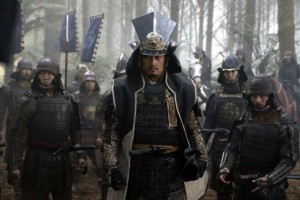There are many samurai movies about honor. What works about Edward Zwick’s 2003 film “The Last Samurai,” is in showing how a code of honor can exist across the divides of countries, in two seemingly different men. The film is about war, about the modernization of a country, and about the violent push and pull between progress and tradition. Unlike epic Samurai movies of old, what differs about this film lies in its scope. This isn’t a film that glorifies war, or even warriors. What it is, beneath it all, is a protracted look at the damaged spirit of one man, the hardened resolve of another, and how both learn from each other in poignant ways.
If “The Last Samurai” is about change, the film explores this theme early and often. For 1870’s Japan, this change comes in the form of buying into Western culture. Modern roads, railways, and armies are sought to help their country enter the new age. Amidst this a small group of Samurai, led by a man named Katsumoto (Ken Watanabe), fight to hold on to the golden age of protecting the Emperor. In a fit of irony, Katsumoto and his Samurai believe they must fight the modernization of their country to serve this cause. Their enemies, led by a man named Omura (Masato Herada), believe their eradication the only path to a new country. This is complicated when Japan hires American Civil War Hero Nathan Algren (Tom Cruise) to help train their new warriors. But Algren’s life changes in profound ways when he is captured by the Samurai during battle, and slowly comes to love the culture of the very people he has come to destroy.

“The Last Samurai” succeeds in mixing these two men together in unique ways. And it hammers its point home with devoted filmmaking. Cruise is subdued here, and on the top of his game. His crass lifestyle crashes headfirst into a culture he does not understand, but one he comes to respect. “They are an intriguing people,” he writes in his journal. “From the moment they wake they devote themselves to the perfection of whatever they pursue.” He also goes through a powerful personal transformation, forced to confront his demons for the first time in many years. An alcoholic who goes though painful withdrawals away from his supply of whiskey, he also confronts a burden on his heart from shameful deeds he has committed as a soldier. He comes to odds with his old commanding officer (Tony Goldwyn), as he struggles to forgive himself throughout.
The acting in this film is top of the line. Five minutes in you forget you are watching Tom Cruise, forget about films such as “Mission Impossible,” and he simply becomes Nathan Algren. He imbues needed emotion into some of the film’s more dramatic sequences, becoming first an asset, and then a friend, to his captor Katsumoto. A decorated soldier in his own right, he also comes across believable in the movie’s action sequences that see him facing off against Samurai, Japanese soldiers, and even Ninja assassins. And while this sounds action hero-esque, the fight sequences are painted with the same devotion as the scenes of peace among the Samurai; Cruise makes us believe the proceedings every step of the way.
The film’s cinematography is lush and beautiful, featuring relics of feudal Japan mixed with the gritty crassness of American warfare. It’s easy to fall in love with the look of this film, as well as the culture of the Samurai throughout. The scope of the movie is grand, and all its elements – from the photography, to the acting, to its beautiful score – all work to enhance it along the way. The film won several awards, among them ‘Best Foreign Film’ from the Award of the Japanese Academy. Despite its 2 hour and 34 minute runtime, the film never drags, and pulls you into its old-world setting completely. “The Last Samurai” is a riveting and timeless film that only grows on you during subsequent viewings. An easy recommend.
– by Mark Ziobro